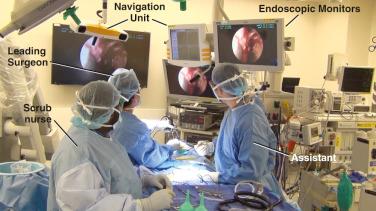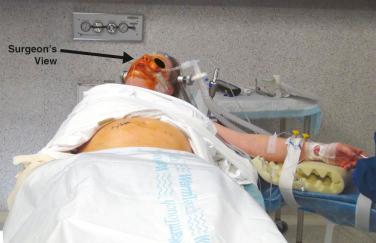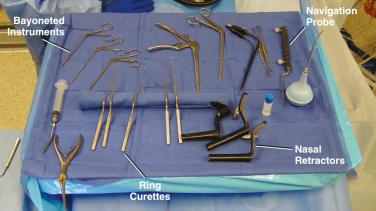Physical Address
304 North Cardinal St.
Dorchester Center, MA 02124
There are many surgical variants of the endoscopic endonasal approach (EEA), which can be used for management of lesions at the ventral skull base.
The main goal of this chapter is to provide the skull base surgeon with strong anatomic and surgical foundations for a safe and efficient endonasal dissection.
The patient positioning and the equipment used during an EEA require an operating room (OR) setup different from that of the classic neurosurgical procedures.
The surgeon stands by the side of the surgical table with direct access to the nostrils of the patient. Generally, the right-handed surgeon will stand at the right of the patient's side to optimize both interactions with the scrubbed nurse standing at the contralateral side, and access to the patient's nostrils ( Figure 23.1 ).

The patient is positioned supine, with the neck slightly extended (10–20°) and the head turned 5–15° towards the surgeon (right) and tilted laterally to the contralateral side (left). The endotracheal tube is directed downwards and towards the left side, away from the surgeon, to avoid obstructing the entry to the nostrils ( Figure 23.2 ).

A neurosurgeon and an ENT surgeon work simultaneously as a skull base team.
The anesthesia team may be positioned close to the feet of the patient to prevent any obstruction of the video monitors.
The endoscope is coupled to a camera that sends video signal — either 2D or 3D — to a set of monitors in the OR.
The rigid endoscopes come in different angles; from the standard 0° to 30°, 40° and 70°, which may be interchanged during the procedure.
The equipment used to aid the EEA usually includes an endoscopic tower, dedicated drill handpieces and a foot-activated irrigation pump attached to an endoscope sheath that directs a stream of saline solution to clean the lens of the endoscope.
Although the EEA dissection technique resembles that of microsurgery, the long and narrow corridor and the endoscope require a specialized set of instruments. Skull base endoscopic sets are available in the market and include long dissectors, monopolar cautery, curettes, bayonet scissors, forceps and bipolars of a variety of shapes and angulations ( Figure 23.3 ).

Several EEA drill sets exist to optimize access and safety during bone removal in the depth of the endonasal corridor. An angled, long thin-sheath drill handpiece is essential for the coronal expanded EEA modules as it allows access away from the midline without obstructing manipulation.
An irrigation pump is used to irrigate the tip of the endoscope for cleaning debris or blood spills from the lens while maintaining the endoscope inside the endonasal corridor.
Stereotactic navigation guidance is common in modern skull base surgery and its use in the EEA is very important.
The navigation system is typically located either between the monitors facing each surgeon, at the patient's head or at the surgeon's side.
If a microsurgical stage is expected, the microscope is properly checked and draped at the beginning of the surgery.
A lumbar drain is always ready in case it needs to be placed at the end of surgery.
A specialized ultrasound probe can be used to locate the internal carotid arteries during the sellar stage of the procedure and is also prepared at the beginning of surgery.
After protecting the eyes and soaking the mid-face with topical iodine solution, the nostrils are cleaned thoroughly with iodine-soaked cottonoids.
The face is completely covered, leaving an opening to expose the nostrils and the nasal cavity is packed with long cottonoids soaked with epinephrine and local anesthetic to reduce bleeding and maximize space during the intranasal phase of the procedure.
While the epinephrine and local anesthetic are being applied, the rest of the OR setup is completed and the surgeon may use this time to harvest abdominal fat or any other autograft for closure if needed. An abdominal fat graft may be needed in those cases where there is a large tumor with suprasellar extension as well as high likelihood of cerebrospinal fluid coming from the resection area (e.g. intraoperative CSF leak). The fat autograft is harvested and kept in warm saline with an antibacterial agent until used for closure. For closure, the fat graft can be wrapped with a procoagulating agent such as Surgicel to improve its adherence.
The assistant surgeon can close the abdominal wound while the nasal phase of the transsphenoidal approach is started.
Become a Clinical Tree membership for Full access and enjoy Unlimited articles
If you are a member. Log in here